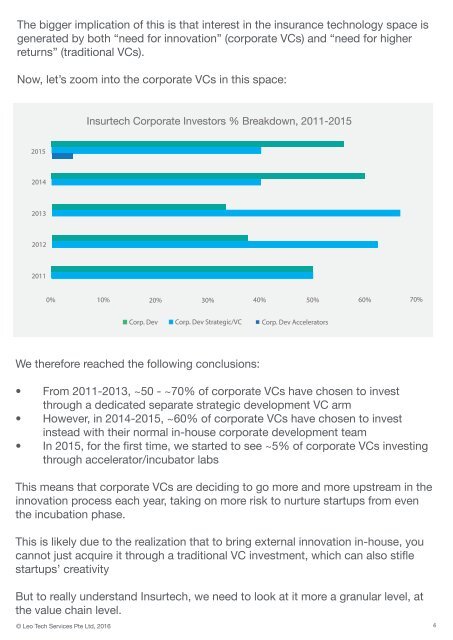LEO TECH SERVICES
Insurtech_White_Paper.compressed
Insurtech_White_Paper.compressed
Create successful ePaper yourself
Turn your PDF publications into a flip-book with our unique Google optimized e-Paper software.
The bigger implication of this is that interest in the insurance technology space is<br />
generated by both “need for innovation” (corporate VCs) and “need for higher<br />
returns” (traditional VCs).<br />
Now, let’s zoom into the corporate VCs in this space:<br />
Insurtech Corporate Investors % Breakdown, 2011-2015<br />
2015<br />
2014<br />
2013<br />
2012<br />
2011<br />
0% 10% 20% 30% 40% 50% 60% 70%<br />
Corp. Dev Corp. Dev Strategic/VC Corp. Dev Accelerators<br />
We therefore reached the following conclusions:<br />
• From 2011-2013, ~50 - ~70% of corporate VCs have chosen to invest<br />
through a dedicated separate strategic development VC arm<br />
• However, in 2014-2015, ~60% of corporate VCs have chosen to invest<br />
instead with their normal in-house corporate development team<br />
• In 2015, for the first time, we started to see ~5% of corporate VCs investing<br />
through accelerator/incubator labs<br />
This means that corporate VCs are deciding to go more and more upstream in the<br />
innovation process each year, taking on more risk to nurture startups from even<br />
the incubation phase.<br />
This is likely due to the realization that to bring external innovation in-house, you<br />
cannot just acquire it through a traditional VC investment, which can also stifle<br />
startups’ creativity<br />
But to really understand Insurtech, we need to look at it more a granular level, at<br />
the value chain level.<br />
© Leo Tech Services Pte Ltd, 2016 4


